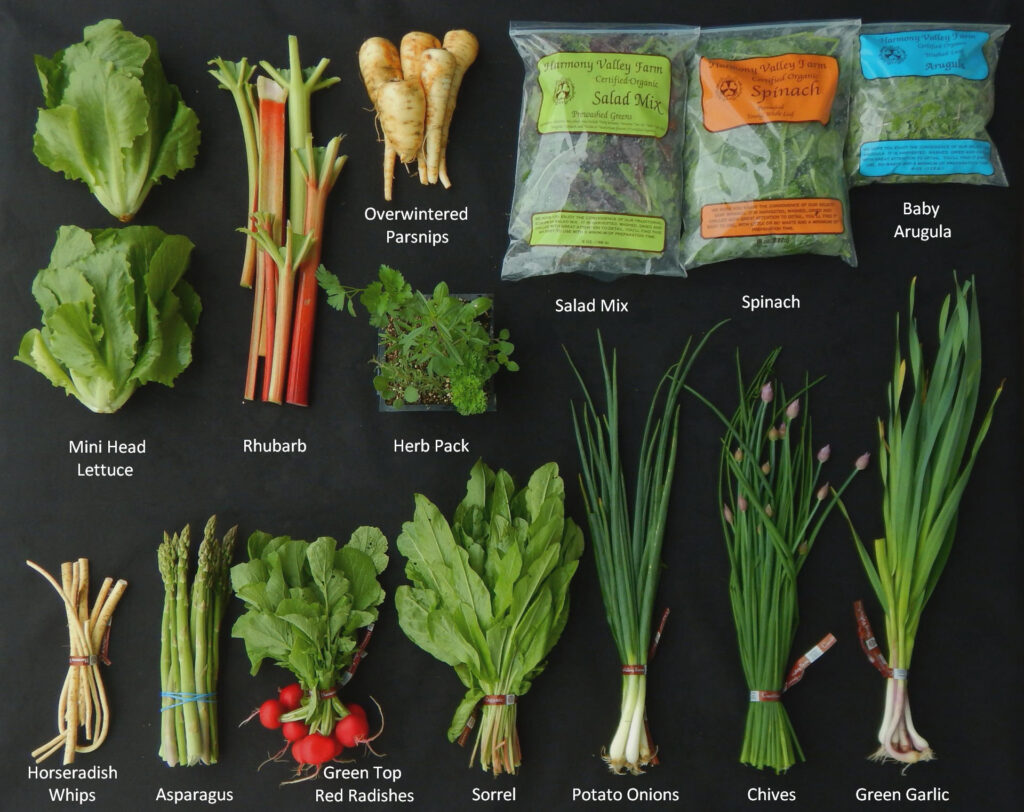What’s In The Box with Recipe Suggestions
Green Garlic: Don’t forget to use both the flat green top and the white base. Substitute green garlic in any recipe that calls for garlic cloves.
Penne with Ricotta & Green Garlic Sauce
Absurdly Addictive Asparagus – Sub green garlic
Chives: These are the long slender, spiky vegetable with a bold onion flavor. There may be purple buds or flower blossoms in your bunch. These are edible too!
Pasta with Sorrel Butter & Nettles – with Chives
Sorrel: Sorrel is the bunched green with arrow shaped leaves. It has a tangy, citrus flavor and may be eaten raw or cooked. When cooked, the leaves turn olive green and soften to the point where they melt into a sauce like texture that is lovely in soups and sauces.
Pasta with Sorrel Butter & Nettles
Strawberry-Orange Sorrel Smoothie
Asparagus: Store asparagus with a moist towel around the base of the spears or put it in a glass with some water in the bottom and store it in the refrigerator to keep it fresh and crisp. Change the water daily if you use this method.
Asparagus and White Bean Salad with Feta and Lemon Dressing
Overwintered Parsnips: These parsnips are a great example of ‘funny shaped’ food that is still tasty and nutritious. They were dug in the spring and are very sweet and flavorful. It’s not uncommon to see some browning on the skin. Peel away the skin and they are solid and snow white on the inside! Store them in the refrigerator in a plastic bag and use them within a few weeks.
Horseradish Whips: We packed a ¼-pound portion for you this week. These thin pieces are called “whips” and grow off the main root. Horseradish stores for a long time, so just keep it in the bag and store it in the refrigerator until you’re ready to use it!
Pepper Crusted Salmon Cakes with Horseradish Sauce
Spinach: This is the first week of the spring planted Spinach. It is small, delicate, and even more tender than the overwintered spinach in the last couple of boxes.
Spinach, Sorrel and Potato Gallette
Red Radish: We’ve been waiting for these pretty little red roots to grow up and they made it for this week’s box! Just trim off the little root end, give them a wash and they are ready to eat. Don’t forget the radish tops, they’re edible too! Chop them up and add them to your morning eggs, use them in a stir-fry or add them to a salad.
Roasted Radish and Herbed Ricotta Omelet
Potato Onions: These are overwintered onions that were planted last fall, came up early this spring, and are ready for us to enjoy now as we wait for our spring planted scallions to grow up. You can eat both the lower portion as well as the greens. They are delicious both raw and cooked, especially roasted or grilled.
Baby Arugula: Don’t be intimidated by its peppery, pungent flavor. The flavor will balance out when you incorporate it with other flavors. Check out this week’s vegetable feature for help identifying and utilizing your arugula.
5 Minute Pesto Breakfast Sandwich
Salad Mix: Our salad mix is a blend of baby lettuces combined with some spicy Asian greens and sometimes kale. Because of their delicate nature, it’s best to dress them with a light vinaigrette instead of a thick, creamy dressing.
Spring Lettuce Salad with Roasted Asparagus
Spring Salad with Rhubarb Vinaigrette
Rhubarb: This is the red and green stalk-like vegetable in your box. Read more about rhubarb and how to use it in both sweet and savory dishes in last week’s Vegetable Feature article. There is a little more than one pound in your box this week.
Parsnip & Ginger Meatballs with Rhubarb Barbecue Sauce
Mini Head Lettuce: These little mini-heads of lettuce are compact varieties that may be grown in small spaces, such as our tunnel greenhouse! Use this lettuce to make a salad or use them as a “scoop” for other dips and fillings.
CHOICE Herb Packs: This week we have sent a garden herb pack for each vegetable share, not per sharing household. Please see the diagram of the herb packs below and on our website so you can identify the herbs in your pack.
Vegetable Feature: Arugula

Arugula is especially popular all around the Mediterranean, which is where this plant originated. It’s eaten on pizzas and pastas and even made into a digestive liqueur in Italy. It’s used commonly in salads and omelets in Greece. It is recommended for newlywed couples in Saudi Arabia, possibly because of its ancient reputation for stirring the libido. In Egypt, arugula is eaten with fava beans for breakfast, and seafood for dinner while those in Turkey make it into a sauce with olive oil and lemon juice to eat with fish. In Slovenia, it is mixed with potatoes or soups, or served with cheese burek, a kind of pastry.
As a brassica, arugula has some amazing health benefits. It’s an excellent source of fiber, Vitamins A, C, and K, folate, calcium, iron, magnesium, phosphorus, potassium and manganese. In addition, arugula contains protein, thiamin, riboflavin, Vitamin B6, zinc, copper and pantothenic acid (Vitamin B5), which raises good cholesterol while lowering bad. Arugula scores over 600 on the ANDI, or Aggregate Nutrient Density Index, which puts it in the top 10 nutrient-dense foods available!
Additionally, arugula’s flavonoids prevent cholesterol from getting stuck in your arteries, lowers blood pressure, increases blood flow, lowers inflammation and improves blood vessel function. Generally, arugula is great for the heart and circulatory system to name just a few health benefits.
Arugula pairs well with roasted and cured meats, cheese, cream, fruit (pears, apples, berries, citrus, etc.), fruity vinegars, mustard, nuts, mushrooms, winter squash and more! It can be used in salads, on sandwiches, included in pasta dishes and much more.
Short & Sweet Weekly Farm Update
We’re feeling pretty good heading into this week. Asparagus and rhubarb production is dropping this week due to the cold weather and almost 3 weeks without rain. We are harvesting our first crop of red radishes and there are more crops very near on the horizon! We are also thankful for a dry start to the week which has allowed us to complete some very important and critical cultivation. Timely weed control with mechanical cultivation and flame weeding is key to decreasing our hand weeding liabilities as well as yields better crops with healthy and vibrant plants!

We pulled back some of the covers on our strawberry field. Some of the early and some of the midseason strawberry varieties have blossoms on them! The blossoms mean in just a few weeks we’ll have strawberries in the field. This is a new planting, and they look good, but the amount of plants emerging through their straw cover is a bit reduced from previous years.
All of our winter barns and lots are cleared, and we have 3 massive windrows being turned every couple of days and maintaining at least 140-160 degrees for the next 15 days. Heat and time will kill any week seeds and pathogens. When we finish, we test each windrow for nutrient content and negative test for pathogens.





